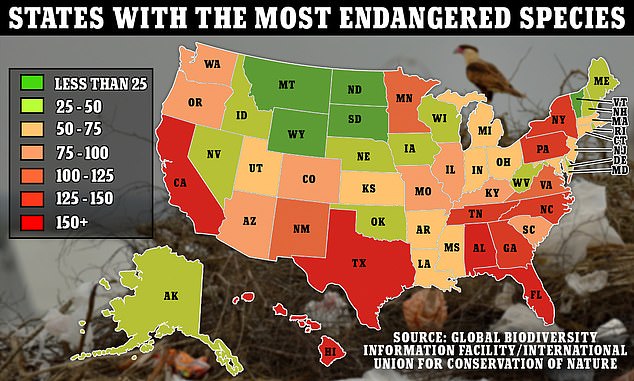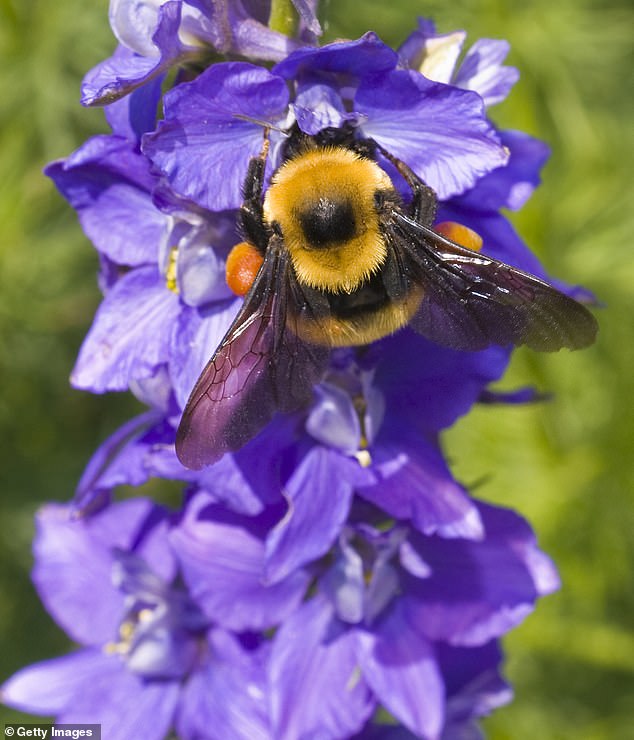The coasts of California and Florida are home to the most endangered species in America
>
Endangered Species Across the United States: Coastal California and Florida are home to the most threatened species, with more than 300 each, while landlocked states like Montana and Wyoming have fewer than 25.
- An investigation was conducted to celebrate the 50th anniversary of the Endangered Species Act
- California has the most endangered creatures with 368, followed by Florida
- Texas, Alabama, and New York also have high lists of near-extinct species.
- Wyoming, Idaho, and the Dakotas have the fewest endangered species
California and Florida are home to hundreds of endangered species, the majority in the United States, according to conservation researchers.
The numbers come from a state-by-state analysis of the endangered species that call which parts of the United States home, according to the International Union for Conservation of Nature’s Red List of Threatened Species.
The organization ranks various creatures by their risk of global extinction and shows where they are native to.
An original breakdown was created by a reddit user intended to celebrate the 50th anniversary of the signing of the United States Endangered Species Act.
The law was signed by President Richard Nixon after near unanimous passage in the House and Senate in late 1973.
It is designed to protect endangered species from extinction caused by ‘economic growth and development not tempered by adequate concern and conservation’.
In a ruling upholding the law, the Supreme Court called it “the most comprehensive legislation for the preservation of endangered species enacted by any nation.”
California leads the nation, with 368 different endangered species calling the Golden State home.
Some of the state’s endangered residents include sea otters, several different species of sea snails, and dozens of different types of rare plant life.
Florida comes in second with 341, and unsurprisingly, the state’s endangered species include many marine creatures.
In addition to aquatic life such as turtles and hammerhead sharks, it also has many endangered migratory birds.
Texas and Alabama have the third highest number of endangered species, with 181 and 169, respectively.

The Lone Star State is home to a few monkey species (found in zoos) on the list, while Alabama contains everything from rabbits to bats.
The northern state with the most threatened species is New York, where creatures as diverse as whales and gazelles have been found.
The four US states with the fewest endangered species are landlocked and border each other: Montana (18), Wyoming (20), North Dakota, and South Dakota (both 21).
Those areas are home to everything from whooping cranes to rare bumblebees, which have disappeared from large swaths of the country.
In June, the White House announced plans to strengthen the ESA after rollbacks were instituted during the Trump administration.

In June, the Biden White House announced plans to strengthen the ESA after rollbacks were instituted during the Trump administration.

US bumblebees are limited to eight states as they move closer to extinction
“This is a decisive move to undo the damage done by the previous administration to the fundamental law that protects threatened and endangered animal species and their habitat,” said Sara Amundson, president of the SPCA Legislative Fund. , said in a statement at the time.
‘Among other measures, federal agencies under the previous administration made it more difficult to grant and maintain protections for endangered species and created exclusions that cater to both state and special interests that privileged profit and economic development over the survival of endangered wildlife’. Amundson added. “Things aren’t supposed to work that way when it comes to ESA protections.”
Among other initiatives, the Department of the Interior under the Biden presidency has reinstated a long-standing policy extending protections to species listed by the ESA as “threatened,” including from being caught, shot, harassed, or harmed. otherwise.
